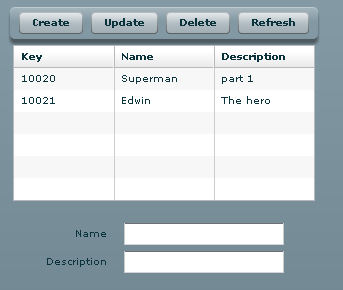In this Blog entry I will use RubyAMF. With RubyAMF I can use RemoteObject, RubyAMF will convert the Ruby datatypes to the Flex datatypes and it is really fast.
If you want more information on RubyAMF just click here or go to the RubyAMF discussion groups
Let's create a new Flex Ruby application where we will use RubyAMF. I will create a small comic entry application.
Create a new RoR application:
rails comics_catalog
Change directory to the new comics_catalog folder:
cd comics_catalog
Edit the database connection file ( comics_catalog\config\database.yml ) with the right connection.
Update the project with RubyAMF:
ruby script/plugin install http://rubyamf.googlecode.com/svn/tags/current/rubyamf
This will download RubyAMF code and configuration from subversion to your project.
Create the comic table and controller
ruby script/generate rubyamf_scaffold comic
Edit the comic table configuration. Go to comics_catalog\db\migrate\ folder and edit the 20080827214400_create_comics.rb file. You will have an other filename because of the timestamp. The script need to look like this.
class CreateComics < ActiveRecord::Migration
def self.up
create_table :comics do |t|
t.string :name
t.string :description
t.float :price
t.timestamps
end
end
def self.down
drop_table :comics
end
end
Let's create the comic table in the database
rake db:migrate
The last step in RoR is to configure RubyAMF. For this we need to go the comics_catalog\config folder where we will edit the rubyamf_config.rb file.
require 'app/configuration'
module RubyAMF
module Configuration
ClassMappings.ignore_fields = ['created_at','created_on','updated_at','updated_on']
ClassMappings.translate_case = true
ClassMappings.assume_types = false
ParameterMappings.scaffolding = false
ClassMappings.register(:actionscript => 'Comic',
:ruby => 'Comic',
:type => 'active_record',
:attributes => ["id","name","description","price", "created_at", "updated_at"])
ClassMappings.force_active_record_ids = true
ClassMappings.use_ruby_date_time = false
ClassMappings.use_array_collection = false
ClassMappings.check_for_associations = false
ParameterMappings.always_add_to_params = true
end
end
I use ClassMappings.ignore_fields because I want to ignore the automatic created fields Ruby will fill these field automatically.
ClassMappings.translate_case is important if you want to Java naming style. RubyAMF will convert created_at to createdAt.
ClassMappings.assume_types is important if you do your know class mapping. In our case we will create the comic class in Flex too so we don't need this. This will give us a little more performance.
ParameterMappings.scaffolding is handy if you just want to pass an comic object or id to the delete method else you need to use {id:dg.selecteditem.id}
ClassMappings.register(:actionscript => 'Comic'. Don't use the package name just put in the actionscript class name.
Start the Ruby server
ruby script/server
Now we can go to Flex, where we create an new application.
first create a comic actionscript object
package vo
{
[RemoteClass(alias="Comic")]
[Bindable]
public class Comic
{
public var id:int;
public var name:String;
public var description:String;
public var price:Number;
public var createdAt:Date;
public var updatedAt:Date;
public function Comic()
{
}
}
}
And here is the mxml code.
<?xml version="1.0" encoding="utf-8"?>
<mx:Application xmlns:mx="http://www.adobe.com/2006/mxml"
creationComplete="loadAll2();">
<mx:Script>
<![CDATA[
import mx.rpc.AsyncToken;
import mx.rpc.events.FaultEvent;
import mx.rpc.events.ResultEvent;
import mx.controls.Alert;
import vo.Comic;
[Bindable]
private var comics:Array = new Array();
private function loadAll2():void {
var token:AsyncToken = AsyncToken(comicService.find_all());
token.kind = "fill";
}
private function save2():void {
var comic:Comic = new Comic();
comic.id = dg2.selectedItem.id;
comic.name = Name2.text;
comic.description = Description2.text;
var token:AsyncToken = AsyncToken(comicService.save(comic));
token.kind = "save";
}
private function create2():void {
var comic:Comic = new Comic();
comic.name = Name2.text;
comic.description = Description2.text;
var token:AsyncToken = AsyncToken(comicService.save(comic));
token.kind = "create";
}
private function destroy2():void {
var token:AsyncToken = AsyncToken(comicService.destroy(dg2.selectedItem.id));
token.kind = "delete";
}
private function faultHandler(event:FaultEvent):void {
Alert.show(event.fault.faultString + " : " + event.fault.faultCode + " : " + event.fault.faultDetail , "Error in LoginCommand");
}
private function resultHandler2(event:ResultEvent):void {
if ( event.token.kind == "fill" ) {
comics = event.result as Array;
} else {
loadAll2();
}
}
]]>
</mx:Script>
<mx:RemoteObject id="comicService" destination="rubyamf"
endpoint="http://localhost:3000/rubyamf_gateway/"
source="ComicsController"
showBusyCursor="true"
result="resultHandler2(event)"
fault="faultHandler(event)" />
<mx:ApplicationControlBar>
<mx:Button label="Create" click="create2()"/>
<mx:Button label="Update" click="save2()"/>
<mx:Button label="Delete" click="destroy2()"/>
<mx:Button label="Refresh" click="loadAll2()"/>
</mx:ApplicationControlBar>
<mx:DataGrid id="dg2" dataProvider="{comics}">
<mx:columns>
<mx:DataGridColumn dataField="id" headerText="Key"/>
<mx:DataGridColumn dataField="name" headerText="Name"/>
<mx:DataGridColumn dataField="description" headerText="Description"/>
</mx:columns>
</mx:DataGrid>
<mx:Form >
<mx:FormItem label="Name">
<mx:TextInput id="Name2" text="{dg2.selectedItem.name}" />
</mx:FormItem>
<mx:FormItem label="Description">
<mx:TextInput id="Description2" text="{dg2.selectedItem.description}"/>
</mx:FormItem>
</mx:Form>
</mx:Application>
That's All

excelente!
ReplyDeleteentonce RubyonRails tiene mucho futuro?
I try to update the data but do not change the values. by
ReplyDeletewhat?
Great example. Caused me a lot of grief trying to experiment with mapping other classes than just Comic. Thought it was a rubyamf problem. It was not.
ReplyDeleteUnless you instantiate a class, ActionScript does not include the class in the compiled swf file.
Thus, if you create a new public class TestClass with a RemoteClass alias tag (and corresponding RoR class) to play with in this example, put a new TestClass() declaration in mxml file and it will all work.
Hope this saves someone some time.
Thank you Sir for this great tutorial. After pondering over so many tutorials i at last was truly successful at connecting Rails with Flex. On top of the world. Hope to see some more posts/tutorials related to rails and flex in future. Especially to do with ActiveMessaging implementation in Flex. :) thank you again.
ReplyDeleteobrigado pelo post!!!
ReplyDelete